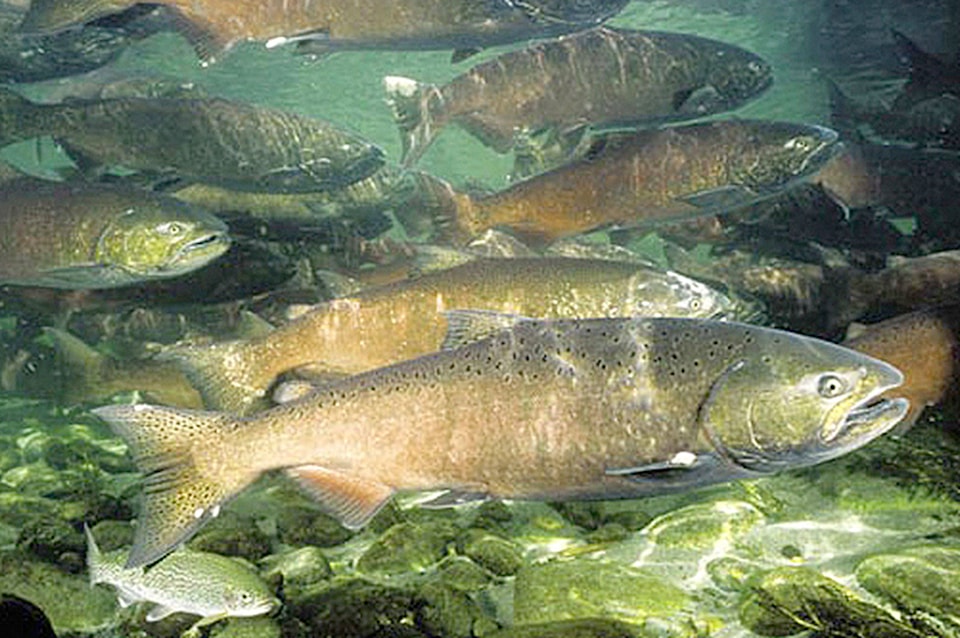Reactions were mixed in Campbell River following news that anglers can’t keep any chinook salmon caught in area waters until July 15, with a total annual catch limited to 10 per person compared to 30 previously.
When the recreational fishery for the Johnstone Strait and northern Strait of Georgia opens in mid-July, local fishers will be allowed to catch one chinook per day, according to the policy announced by Fisheries and Oceans Canada (DFO) on Tuesday.
From Aug. 30 until Dec. 31, the limit is two per day in waters around Campbell River. Two chinook per day was the year-round limit before restrictions implemented last year, according to Jeremy Maynard, a fishing tourism operator.
He said the new measures will deal a significant blow to sports fishing enterprises, tackle stores, hotels and other businesses in fishing destinations like Campbell River.
“The ripple effect’s going to be huge in this community, and in communities all around the inner south coast,” Maynard said.
But the tougher caps are urgently needed to protect wild salmon stocks that are in a long-term state of decline, according to DFO.
“Chinook salmon populations have been in decline for years as a result of a number of factors including habitat destruction, harvest, and the effects of climate change,” DFO said in a media release, adding that a recent study of Fraser River chinook found that 12 of 13 assessed populations were at risk.
READ MORE: Campbell River anglers concerned over possibility of chinook closure
Maynard, who is the chairperson of the Sports Fishing Advisory Board’s chinook and coho working group, said climate change is largely to blame for the decline of wild chinook populations from the interior Fraser River watershed.
But certain chinook populations remains strong, including those on the Cowichan and the Puntledge rivers, he said.
“Even though our impact in the Campbell River area or the Strait of Georgia area is extremely small on the particular stocks of concern, we do encounter some of them,” Maynard said.
“There are some chinook stocks that are doing well but, unfortunately, they’re all mixed up in the ocean,” he said.
Maynard was involved in DFO’s consultations about the new policy.
He said that instead of the new limits, a better policy would be to clip the adipose fins of chinook from hatcheries, allowing fishers to keep fish from populations that aren’t at risk. The adipose fin is located between the dorsal fin and the tail.
But even if that “mass marking” policy were introduced immediately, it would take several years before the clipped fish would be big enough to keep, he said.
READ MORE: Fisheries Department announces conservation measures to protect chinook in B.C.
The non-retention policy means that perhaps 30 per cent of chinook sports fishing packages will be lost at Painter’s Lodge and April Point, according to Patrick Blanch, director of operations for the popular resort.
“I think it’s going to have a significant impact on the community, not just our properties,” Blanch said.
But the changes didn’t come out of the blue and are likely necessary for sustainability, he said.
“Sustainability is something we believe very strongly in, as a group,” he said. “I think it’s for the greater good.”
The company’s marine operations manager was included in talks with DFO ahead of Tuesday’s policy announcement, he said.
Blanch also said he’s confident that opportunities including catch-and-release trips and fishing for other species will still provide an experience “that we believe is unique and unparalleled.”
Local conservationist Sandra Milligan, president of the Greenways Land Trust, said she supports restrictions on chinook fisheries – though she noted that people should look at the big picture, including what she described as a relatively high economic value per fish of recreational chinook compared to the commercial fishery.
She also noted that on the Island’s west coast, the inshore recreational limit is two chinook per day after at-risk chinook stocks have passed through. Milligan also noted that she’s married to a sport fishing guide, and they’re expecting cancellations on fishing cruises to start immediately.
“I obviously would prefer my husband has as many guests out on the water as possible, but I recognize the need for caution,” she said in an email.
Milligan, an instructor at Campbell River’s North Island College campus, also stressed the importance of salmon spawning habitat amid the declining wild stocks.
READ MORE: Campbell River’s urban trees to receive protection
“This emphasizes the need to protect and improve our salmon’s birth place – our own urban streams and the trees that support them,” she said, noting that a tree protection bylaw would be “one of the best ways to ensure our streams continue to produce salmon.”
The City of Campbell River included funding for the development of a tree protection bylaw and the hiring of a full-time arborist in this year’s budget. City staff is currently in the process of hiring the arborist and is looking into options for a bylaw over the summer, according to senior planner Chris Osborne.
@davidgordonkoch
david.koch@campbellrivermirror.com
Like us on Facebook and follow us on Twitter
